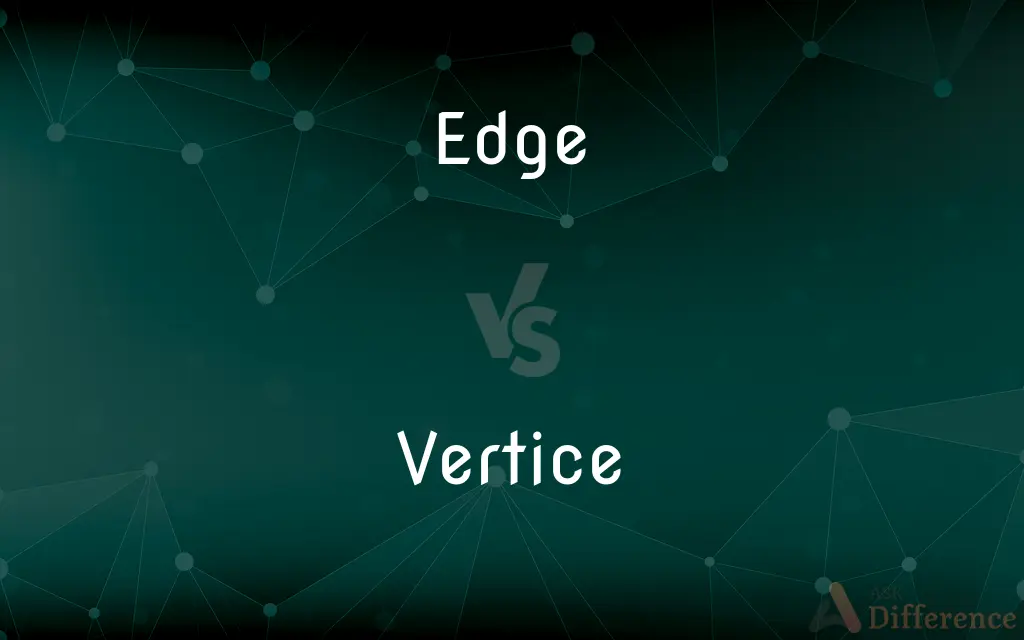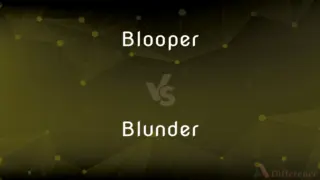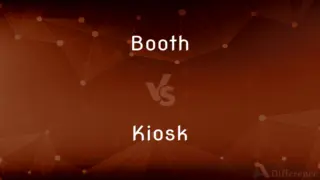Edge vs. Vertice — What's the Difference?
By Tayyaba Rehman & Maham Liaqat — Updated on May 21, 2024
Edge refers to the line segment connecting two vertices in a graph or geometric shape, while a vertice (or vertex) is a point where two or more edges meet.

Difference Between Edge and Vertice
Table of Contents
ADVERTISEMENT
Key Differences
Edge refers to the straight or curved line segment that connects two vertices in a graph or geometric figure. It is a fundamental component in graph theory, forming the connections between nodes or points. An edge represents a relationship or link between two points. Vertice, more commonly known as vertex (plural: vertices), is the point where two or more edges meet. In geometry, a vertex is the corner point of polygons and polyhedra, such as the tip of a pyramid or the corners of a cube. In graph theory, vertices are the fundamental units connected by edges.
Edge is essential in defining the shape and structure of geometric figures and graphs. It dictates the connections and pathways between points. For instance, in a triangle, the edges are the sides that connect the three vertices. Vertice, on the other hand, marks the position of junctions or intersections in shapes and graphs. Each vertex represents a key point of connection, such as the corner of a polygon or the node in a network.
Edges and vertices together define the topology of a graph or geometric shape. While edges describe the relationships and connections, vertices denote the critical points of these connections.
In computer graphics and computational geometry, edges and vertices are used to model and render 3D shapes. Edges determine the contours and outlines, whereas vertices establish the key points that shape the object.
Comparison Chart
Definition
Line segment connecting two vertices
Point where two or more edges meet
ADVERTISEMENT
Role in Geometry
Forms sides of polygons and polyhedra
Forms corners or intersections of shapes
Role in Graph Theory
Represents links between nodes
Represents nodes or points in a graph
Usage Example
Sides of a triangle
Corners of a cube
Terminology Variations
None
Also known as vertex (plural: vertices)
Compare with Definitions
Edge
The line where two faces of a polyhedron meet.
The cube has 12 edges.
Vertice
A node in a graph or network.
Each vertice in the diagram represented a computer.
Edge
The outside limit of an object, area, or surface
She perched on the edge of a desk
A willow tree at the water's edge
Vertice
A corner point of a polygon or polyhedron.
The vertices of the cube were labeled.
Edge
The sharpened side of the blade of a cutting implement or weapon
A knife with a razor-sharp edge
Vertice
A key point defining the shape of a geometric figure.
The pyramid had five vertices.
Edge
A quality or factor which gives superiority over close rivals
His cars have the edge over his rivals'
Vertice
A point where two or more edges meet.
The corner of the triangle is a vertice.
Edge
Provide with a border or edge
The pool is edged with paving
Vertice
An intersection point in a geometric shape.
The hexagon has six vertices.
Edge
Move or cause to move gradually or furtively in a particular direction
Hazel quietly edged him away from the others
She tried to edge away from him
Vertice
(non-standard) vertex
Edge
Give an intense or sharp quality to
The bitterness that edged her voice
Edge
Strike (the ball) with the edge of the bat; strike a ball delivered by (the bowler) with the edge of the bat
Haynes edged to slip
He edged a ball into his pad
Edge
Ski with one's weight on the edges of one's skis
You will be edging early, controlling a parallel turn
Edge
A thin, sharpened side, as of the blade of a cutting instrument.
Edge
The degree of sharpness of a cutting blade.
Edge
A penetrating, incisive quality
"His simplicity sets off the satire, and gives it a finer edge" (William Hazlitt).
Edge
A slight but noticeable sharpness, harshness, or discomforting quality
His voice had an edge to it.
Edge
Keenness, as of desire or enjoyment; zest
The brisk walk gave an edge to my appetite.
Edge
The line or area farthest away from the middle
Lifted the carpet's edge.
Edge
The line of intersection of two surfaces
The edge of a brick.
Edge
A rim or brink
The edge of a cliff.
Edge
The point at which something is likely to begin
On the edge of war.
Edge
A margin of superiority; an advantage
A slight edge over the opposition.
Edge
To give an edge to (a blade); sharpen.
Edge
To tilt (a ski or both skis) in such a way that an edge or both edges bite into the snow.
Edge
To put a border or edge on
Edged the quilt with embroidery.
Edge
To act as or be an edge of
Bushes that edged the garden path.
Edge
To advance or push slightly or gradually
The dog edged the ball with its nose.
Edge
To trim or shape the edge of
Edge a lawn.
Edge
To surpass or beat by a small margin. Often used with out
The runner edged her opponent out at the last moment.
Edge
To move gradually or hesitantly
The child edged toward the door.
Edge
The boundary line of a surface.
Edge
(geometry) A one-dimensional face of a polytope. In particular, the joining line between two vertices of a polygon; the place where two faces of a polyhedron meet.
Edge
An advantage.
I have the edge on him.
Edge
The thin cutting side of the blade of an instrument, such as an ax, knife, sword, or scythe; that which cuts as an edge does, or wounds deeply, etc.
Edge
A sharp terminating border; a margin; a brink; an extreme verge.
The cup is right on the edge of the table.
He is standing on the edge of a precipice.
Edge
Sharpness; readiness or fitness to cut; keenness; intenseness of desire.
Edge
The border or part adjacent to the line of division; the beginning or early part (of a period of time)
In the edge of evening
Edge
(cricket) A shot where the ball comes off the edge of the bat, often unintentionally.
Edge
(graph theory) A connected pair of vertices in a graph.
Edge
A level of sexual arousal that is maintained just short of reaching the point of inevitability, or climax.
Edge
The point of data production in an organization (the focus of edge computing), as opposed to the cloud.
Edge
(transitive) To move an object slowly and carefully in a particular direction.
He edged the book across the table.
The muggers edged her into an alley and demanded money.
Edge
(intransitive) To move slowly and carefully in a particular direction.
He edged away from her.
Edge
(usually in the form 'just edge') To win by a small margin.
Edge
To hit the ball with an edge of the bat, causing a fine deflection.
Edge
(transitive) To trim the margin of a lawn where the grass meets the sidewalk, usually with an electric or gas-powered lawn edger.
Edge
(transitive) To furnish with an edge; to construct an edging.
Edge
To furnish with an edge, as a tool or weapon; to sharpen.
Edge
(figurative) To make sharp or keen; to incite; to exasperate; to goad; to urge or egg on.
Edge
To delay one's orgasm so as to remain almost at the point of orgasm.
Edge
The thin cutting side of the blade of an instrument; as, the edge of an ax, knife, sword, or scythe.
He which hath the sharp sword with two edges.
Slander,Whose edge is sharper than the sword.
Edge
Any sharp terminating border; a margin; a brink; extreme verge; as, the edge of a table, a precipice.
Upon the edge of yonder coppice.
In worst extremes, and on the perilous edgeOf battle.
Pursue even to the very edge of destruction.
Edge
Sharpness; readiness or fitness to cut; keenness; intenseness of desire.
The full edge of our indignation.
Death and persecution lose all the ill that they can have, if we do not set an edge upon them by our fears and by our vices.
Edge
The border or part adjacent to the line of division; the beginning or early part; as, in the edge of evening.
Edge
To furnish with an edge as a tool or weapon; to sharpen.
To edge her champion's sword.
Edge
To shape or dress the edge of, as with a tool.
Edge
To furnish with a fringe or border; as, to edge a dress; to edge a garden with box.
Hills whose tops were edged with groves.
Edge
To make sharp or keen, figuratively; to incite; to exasperate; to goad; to urge or egg on.
By such reasonings, the simple were blinded, and the malicious edged.
Edge
To move by little and little or cautiously, as by pressing forward edgewise; as, edging their chairs forwards.
Edge
To move sideways; to move gradually; as, edge along this way.
Edge
To sail close to the wind.
I must edge up on a point of wind.
Edge
The boundary of a surface
Edge
A sharp side formed by the intersection of two surfaces of an object;
He rounded the edges of the box
Edge
A line determining the limits of an area
Edge
The attribute of urgency;
His voice had an edge to it
Edge
A slight competitive advantage;
He had an edge on the competition
Edge
A strip near the boundary of an object;
He jotted a note on the margin of the page
Edge
Advance slowly, as if by inches;
He edged towards the car
Edge
Provide with a border or edge;
Edge the tablecloth with embroidery
Edge
Lie adjacent to another or share a boundary;
Canada adjoins the U.S.
England marches with Scotland
Edge
Provide with an edge;
Edge a blade
Edge
A line segment between two points.
The edge of the square was 5 cm long.
Edge
A boundary line of a polygon.
The triangle has three edges.
Edge
A connection between two nodes in a graph.
Each edge in the network graph represented a friendship.
Edge
A part of a geometric figure defining its shape.
The edges of the pentagon were equal.
Common Curiosities
What shapes have vertices?
Polygons, polyhedra, and graphs all have vertices.
Can a vertex connect more than two edges?
Yes, a vertex can be the meeting point for multiple edges.
What is a vertice?
A vertice, or vertex, is a point where two or more edges meet.
How do edges and vertices differ in graph theory?
Edges represent connections or links, while vertices represent nodes or points.
Do edges have lengths?
Yes, in geometry, edges have measurable lengths.
Is a vertice the same as a vertex?
Yes, vertice is an alternate term for vertex; the plural is vertices.
How are edges important in graph theory?
Edges are crucial for defining the relationships between nodes.
What is an edge in geometry?
An edge is a line segment that connects two vertices in a geometric shape.
Can edges be curved?
Yes, edges can be straight or curved, depending on the shape.
What is a common example of an edge in everyday life?
The edge of a table or a piece of paper is a common example.
How many vertices does a triangle have?
A triangle has three vertices.
What is the role of vertices in polygons?
Vertices are the corner points that define the shape of polygons.
How are edges used in 3D modeling?
Edges define the contours and connections in 3D models.
What determines the number of edges in a polyhedron?
The number of faces and vertices typically determines the number of edges.
Do vertices have coordinates?
Yes, vertices are often defined by their coordinates in space.
Share Your Discovery

Previous Comparison
Blooper vs. Blunder
Next Comparison
Booth vs. KioskAuthor Spotlight
Written by
Tayyaba RehmanTayyaba Rehman is a distinguished writer, currently serving as a primary contributor to askdifference.com. As a researcher in semantics and etymology, Tayyaba's passion for the complexity of languages and their distinctions has found a perfect home on the platform. Tayyaba delves into the intricacies of language, distinguishing between commonly confused words and phrases, thereby providing clarity for readers worldwide.
Co-written by
Maham Liaqat















































